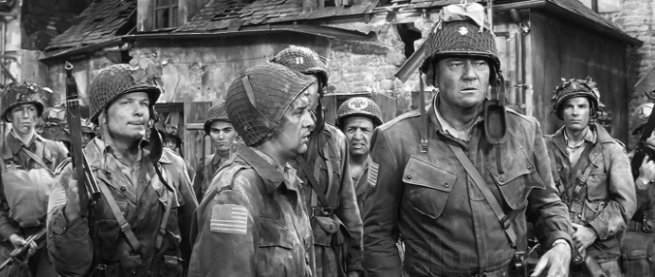Directed by Ken Annakin, Andrew Marton, Bernhard Wicki, Gerd Oswald

The Longest Day is a three hour World War II epic that was completely overshadowed by David Lean’s Lawrence of Arabia. Both films are expansive though in different ways. While Lawrence centers on a single figure over the course of a long, arduous journey, The Longest Day focuses only on June 6, 1944 as the Allied troops stormed the beaches of Normandy. The epic scope comes from the depiction of both sides of the war. We follow an American icon (John Wayne) as he charges into battle, but we’re also in the war room with exhausted German military leaders, lamenting a lack of communication with the Führer and sensing their oncoming defeat.
Bernhard Wicki directed the German scenes (with all dialogue spoken in the native tongue) while Andrew Marton handled the American storyline. Similarly there was a director for the parts of the movie following the British troops and the portion focusing on the French. The result is an impressive collage of that fateful day which took over 10,000 lives.
With the story jumping around among so many characters, it would be easy for the individual stories to get lost among the spectacle. What you might remember most from The Longest Day are the technically impressive, even shocking images of battle. Filmed with thousands of extras (from what I can tell), and using practical effects, the film basks in the undoubtedly captivating violence. In one particular scene the camera rolls continuously for a minute or so, from the height of a low flying helicopter, as soldiers push their way through an exploding village. The violence, from such a vantage point, is less grotesque and hard to bear (as in Saving Private Ryan), but serves to dehumanize the soldiers. They are nothing more than specs on the screen.
The Normandy invasion itself has a similar effect. We often see the bulk of the carnage from far away, looking at the destruction from the perspective of a general standing over a map. The deaths become a numbers game, a necessary part of the plan so long as a certain number of soldiers make it.
At the same time we get to know certain characters on all sides of the war. Some of these moments are deliberately humorous, helping you attach to characters who may or may not survive the next day’s events (as they’re well-aware). These moments are what allow the story to live up to its spectacle. We watch characters make tough decisions and then suffer as a result of some of those decisions.
While the spectacle looms large, other small moments resonate. In one sequence, paratroopers overshoot their target and are slaughtered as they land in a French village overrun with German troops. Some men are gunned down immediately while one falls straight into a well and another hangs limply from a church after his parachute catches on the roof. He is forced to watch his friends die before he himself dies. The camera looms on his face as he takes this in, one of the more horrifying and personal moments of the film.
The personal effect of the war is nearly the same for all who fight in it. German soldiers express the same fear as the Americans. Driven less by national pride at this point and more by a strict need to survive, they cower at the sight of Allied ships on the horizon.
The American soldiers act their part, fighting the good fight, but it’s the French and British soldiers who are the most inspired. The French are out to defend their homeland while a British general reminds his troops about the escape from Dunkirk and reminds them that the people of their homeland have been living under fear for a years now.
The war from the perspective of those in charge remains political, but for those on the ground it’s something much more meaningful. It has to be, to get them through the day.
Some war movies focus on a single person or a single platoon. Many of these movies show the enemy as just that, the enemy. They are never humanized, only representations of danger, of something to be defeated. The enemy is depicted the way I have to imagine they were seen by soldiers on the ground. It’s easier to shoot down the enemy than another human.
While some movies, then, make the enemy either less human if not outright evil, The Longest Day makes sure to show that everyone involved in the war was more or less the same. In separate scenes, an American and German general each wonder if God is really on their side. A previously existing faith is beginning to face doubt at the same time.
Throughout the film, we receive reference to Dwight Eisenhower and Adolf Hitler, though Hitler never goes by name, referred to only as the Führer. The leaders are never depicted, though their presence looms large. There is a disconnect between them and the men on the ground, particularly on the German side where the generals express frustration that they can’t reach the Führer because he’s asleep.
The men on both sides of the war are scared. In a scene near the end, two American soldiers observe the body of a dead German. One of the Americans, who shot the German, is dying and the other is simply afraid. They share a cigarette, and the dying soldier points out that the German put his shoes on the wrong feet. It’s a small moment but one which makes the supposed enemy almost painfully human. He was probably confused because he was scared, they agree.
Up Next: Isle of Dogs (2018), Reality Bites (1994), River’s Edge (1986)
